Aquariums for 200 liters: sizes, how many and what kind of fish can you keep?
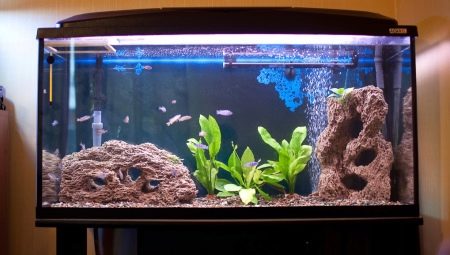
An oversized 200 liter aquarium will enliven the interior of any spacious room. But before bringing such a bulky structure into the house, it is worth learning about the features of the choice, installation and equipment of the future water area. Yes, and you need to populate it wisely. In this article, we will consider in more detail the characteristics of such a capacity, and also get acquainted with the nuances of its operation.

Advantages and disadvantages
The main advantage of a 200 liter aquarium is that it is easy to clean. It quickly adjusts the biobalance, and the inhabitants do not feel constrained.
By the way, a large volume of water allows you to keep large fish.
but before buying a 200-liter aquarium, you should decide in advance where such a tank will be located... After all, he should not interfere with household members, and the fish cannot suffer from extraneous noise, bright sunlight and heat sources.
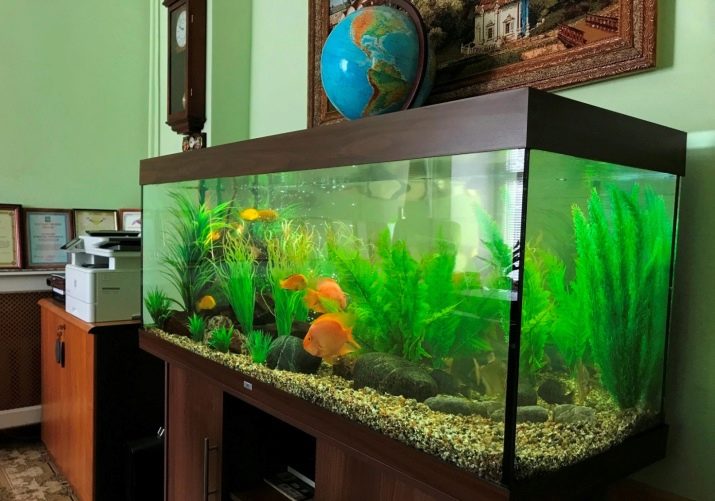
Another important point: such a capacious reservoir is installed on a stable pedestal so that the corners of the aquarium do not go beyond the upper surface.
Large aquariums are not placed on an ordinary table, because their weight exceeds 200 kg. Today in stores, aquariums for 100 and 200 liters come immediately complete with a curbstone. On the one hand, it saves time on finding the right stand, on the other hand, the cost of some sets is a pretty penny.
If the obvious shortcomings do not bother you, you should proceed to the next step: choosing the shape and size of the future home water area.
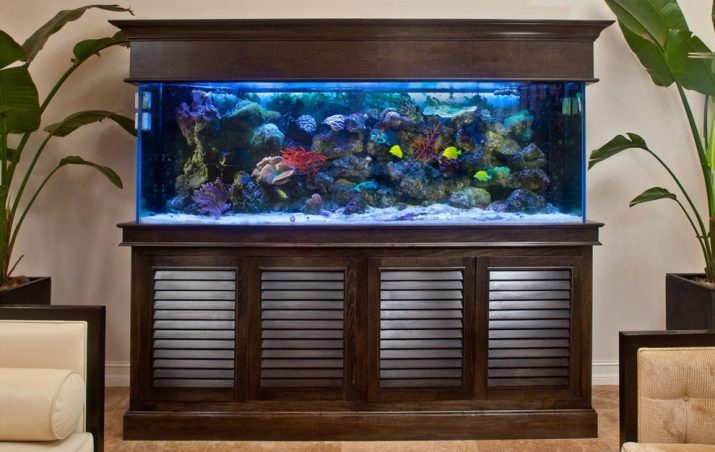
Variants of shapes and sizes
The most affordable and convenient option for a city apartment is a standard rectangular aquarium with parameters 1000 mm in length, 370 in width and 550 in height.The thickness of the glasses is 8 mm, the area of the side surfaces is 354x550, the front surfaces are 1000x550.
Without water, an empty aquarium weighs about 18-20.5 kg, but transporting it requires the help of a delivery service. Together with water, the weight will increase significantly. It is not difficult to calculate it: the volume of water converted into kilograms, plus the weight of the glass, plus the soil and the necessary equipment.
Based on this, it is worth not only choosing a reliable curbstone, but also thinking about the reliability of the beam floors. The latter is especially true for old buildings, which are unlikely to be designed for a load of more than 200 kg.
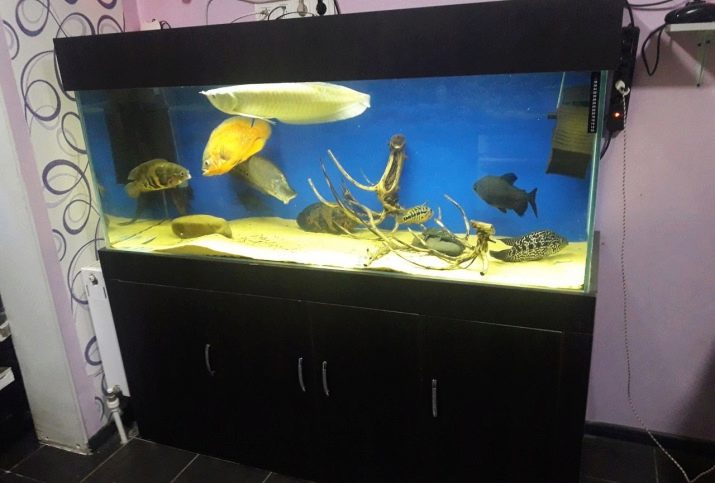
If the reliability of the building is not in doubt, you need to think about the shape of the future water area. In addition to the standard rectangle, today we offer a large selection of corner, wall and panoramic aquariums made of silicate and polymer glass.
The former significantly save space, but since they are installed at the junction, it can be difficult to determine the area of the aquarium leakage. A wall-mounted aquarium is also economical, it also looks stylish, but caring for the inhabitants of such a tank is very difficult. The panoramic version of the aquarium looks original due to the concave glass, but this format distorts its natural dimensions and is demanding on lighting. A better option is the trapezoidal shape, which also provides excellent visibility, but without significant distortion.
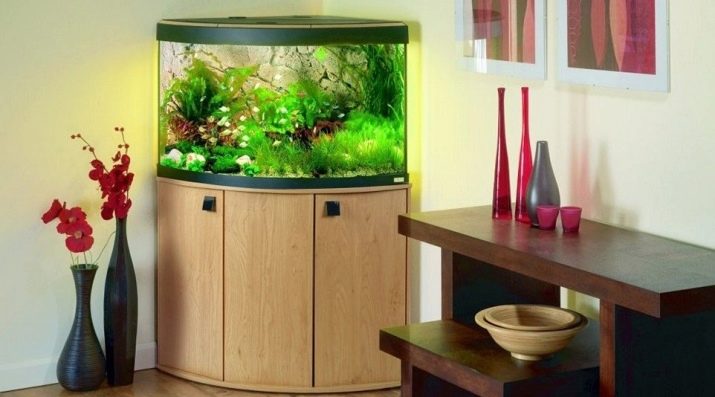
A new-fashioned trend has become the emergence of a screen aquarium, which allows you to zone the room. Its inhabitants can be seen from all sides, and the turbidity of the water is not so noticeable.
However, in such aquariums, fish often suffer from a lack of oxygen, so these structures must be equipped with an additional set of filters.
If the delights are not too interesting, you should pay attention to the usual rectangular containers with a curbstone. After the desired shape is selected, you can proceed directly to the purchase of the aquarium.
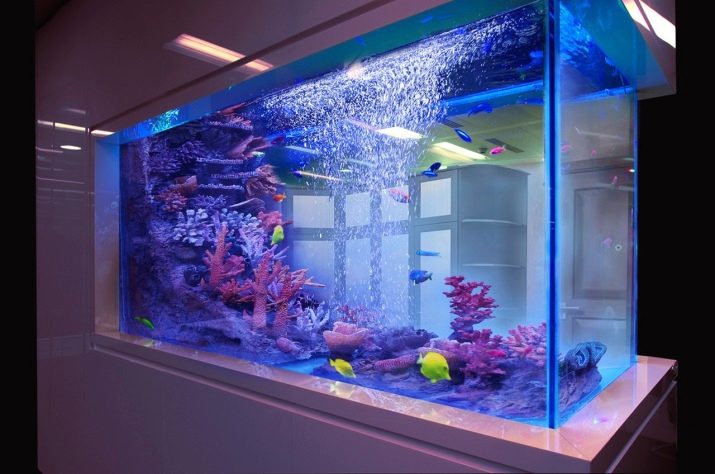
How to choose?
To find a high-quality container, it is worth listening to the following recommendations.
- Do not sign any paperwork until you have thoroughly inspected the aquarium.
- Examine the container for scratches and cracks. The former will be annoying already at the launch stage, while the latter can cause the wall of the aquarium to collapse and the death of its inhabitants.
- The seams should be even, without dips and bumps. The walls of the aquarium should be free of traces of sealant.
- The reservoir must not contain chips or abrasions, and its ends must be sanded.
- It will be necessary to have stiffeners - glass strips up to 5 cm wide, glued perpendicular to the walls of the aquarium.
When buying an aquarium in a pet store, the buyer is provided with a warranty card. If you plan to buy a container from your hands, already at the selection stage you should pay attention to the price: a too budgetary option should raise questions about the quality of the aquarium.
If the seller refuses to share information about the condition of the tank, you need to look for a more adequate consultant. At a personal meeting, you should make sure that the future fish house is in perfect order, and the equipment (if any) is in good condition.
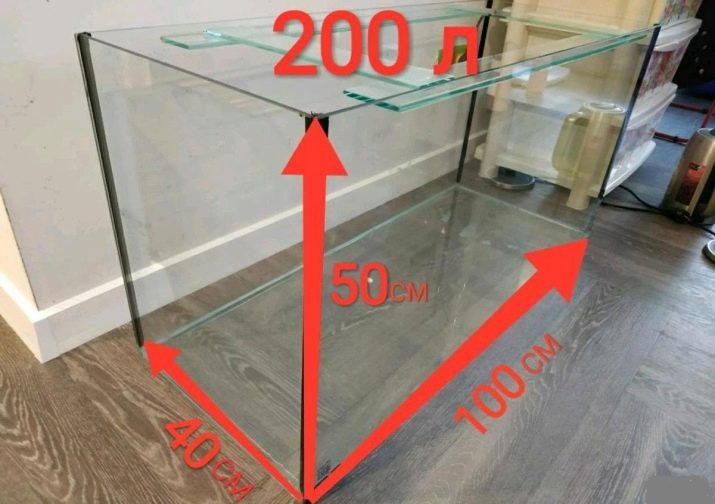
How to equip?
The equipment was mentioned for a reason: right after buying an aquarium, you should select the necessary devices that will support life in your home water area. Arranging a 200 liter aquarium is not much different from a smaller container.
It also requires a heater, filter, compressor and siphon. Filters can be external, internal, built-in and hinged. If the choice fell on filters without aeration, the purchase of a compressor is simply a must. Particular attention should be paid to lighting. It is no coincidence that aquariums are immediately sold with a lid, or this necessary attribute is purchased separately. After all, it is on the inner side of the cover that LED lamps or LED spotlights are installed.
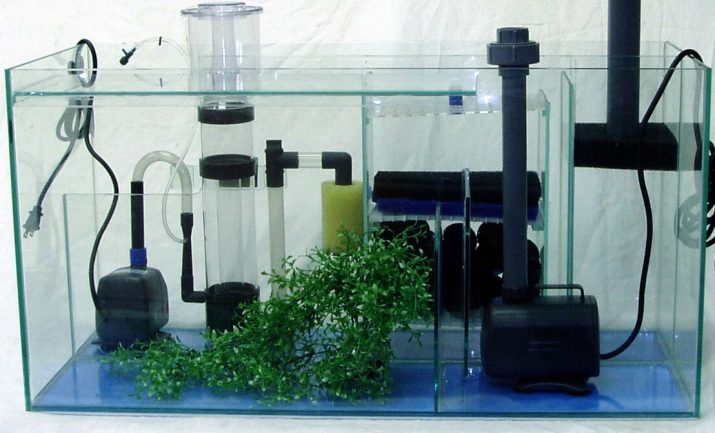
These light sources have gained great popularity due to their quiet operation, long service life and low power consumption. It is important that during long-term operation (over 50 thousand hours) the spectrum of the emitted light does not change. LED floodlights are resistant to mechanical damage, increased water resistance and safety, as they do not contain mercury. Another advantage is their low heat transfer: they do not heat the water in the aquarium, so the liquid does not need constant cooling.
If you plan to settle corals in your home area, you should take a closer look at more powerful metal halide lamps. Their luminous flux is much wider than that of LEDs.
However, metal halide lamps become hot, so they should be mounted 30 cm away from the aquarium surface, which creates additional inconvenience when caring for the inhabitants of the aquarium.
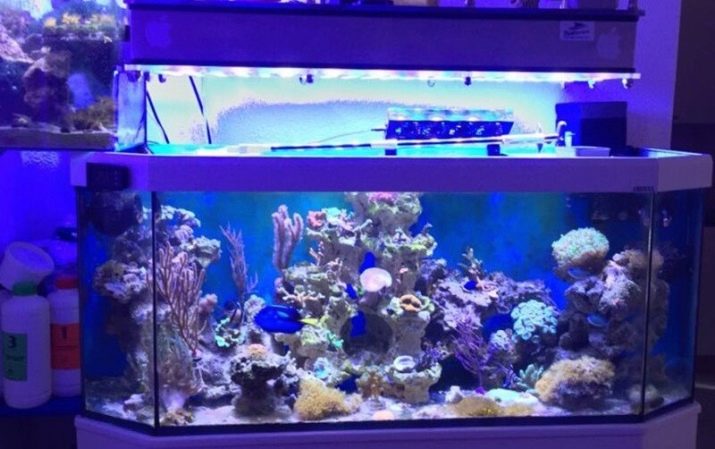
Where to install?
Typically, the location of the aquarium is determined long before buying it. But when the container with the equipment arrived from the store, it is worth making sure that the "parking" of the future water area really does not bother anyone, and the inhabitants of the home reservoir will be comfortable. The cabinet with the aquarium should be in a quiet, dark place, away from the TV screen, computer and stereo system. At the same time, there should be a lot of space around it so that maintaining the aquarium and caring for the inhabitants does not cause discomfort.

Ideally, a socket with a tee should be located next to the container through which light, heaters, filters will be connected.
If it is not nearby, you will have to pull the cord from the extension cord, which will create additional inconvenience. It is not uncommon for beginners to try to set up a feng shui aquarium: in the northeast or south of an apartment for an influx of finance, or on the east side to soften the tense home atmosphere.
If these parties meet the conditions for a comfortable living for fish, they should be listened to. But if there are sleeping places in the so-called favorable zones, it is better for the fish to look for a place in the corridor or living room. After all, the operation of compressors and filters is never silent, and chronic lack of sleep does not contribute to pacification.
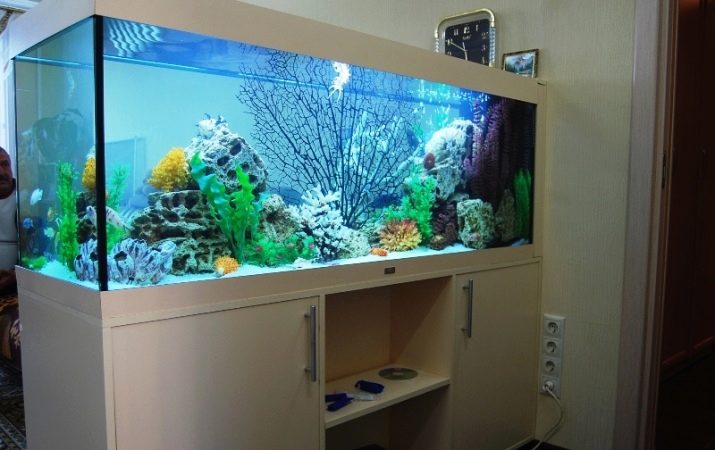
How many and what kind of fish can you keep?
There are many ways to calculate the number of fish for an aquarium of any size, but none of them is extremely accurate. Therefore, experts advise to proceed from the amount of water per individual. For example, one discus requires at least 50 liters, for a cockerel - 1.5 liters per bird... Small cichlids are populated in pairs at the rate of 40 liters for two. Malawian cichlids require 10 liters per bird. They are not afraid of overpopulation - on the contrary, they become less aggressive.
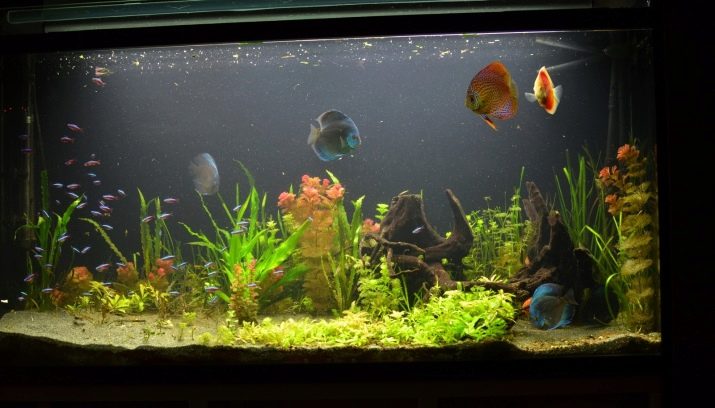
Goldfish, scalars, gourami, Malabar danios need at least 30 liters per individual. There are no specific recommendations on the number of these fish - it all depends on the nature, behavior and habits of the specimens you like. Small and small fish should not be discounted. For example, neon, guppy, cardinal, and rassor require only 1 liter per individual. Pecilia, thorns, barbus and rhodostomus - one and a half, and swordtails and mollies - 3-10 liters of water. For a flock, less water will be required, and for one instance - at least five liters.
Bottom fish species are not counted, but the capacity of the aquarium allows one large specimen or several related fish to be populated.
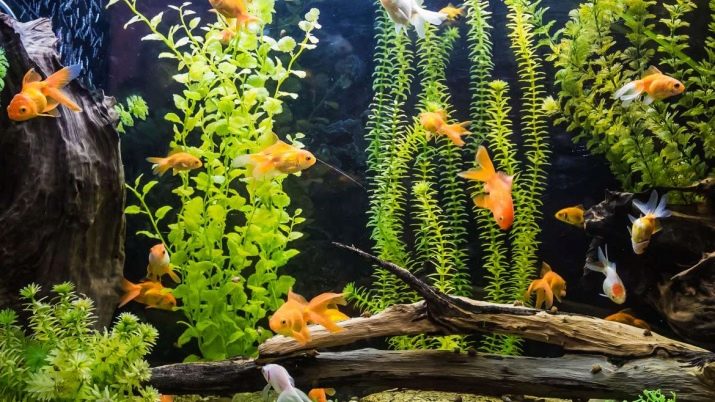
The dimensions of the container allow you to visit the aquarium and predatory fish. It can be a poisonous sack-gill catfish, which feels great not only in the aquatic environment, but also on land: inside its body there are sacs in which the fish stores water. One knife cichlid should have at least 100-150 liters of water, since this hunter loves space and does not tolerate curious neighbors. The spotted Indian knife and white-lime aperonotus are very aggressive and do not even tolerate representatives of their own species. These predators should be settled at the rate of 200 liters per individual. A flock of pineapples or crawlers of 4-5 individuals will require the entire volume of a 200-liter aquarium. The tetradon is a more compact predator - some representatives occupy only one liter per individual.
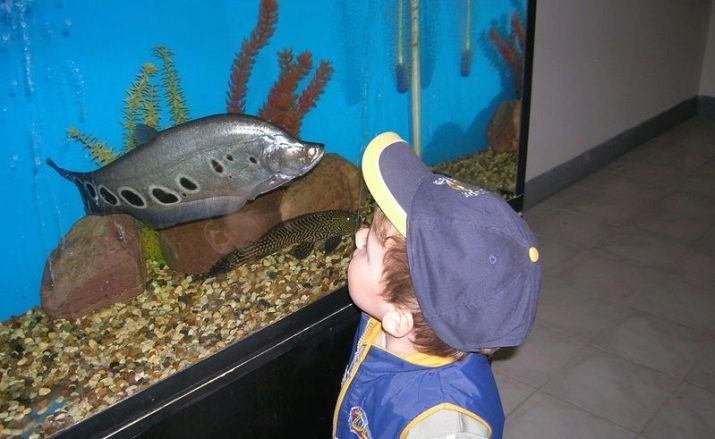
Exotic fish have always attracted interest, but keeping predators is fraught with certain difficulties: many species prefer live food in the form of fry, do not refuse chicken or beef, and eat snails. As a result, the water becomes polluted more quickly, and the aquarium will need to be cleaned more often. Another important point is the selection of the neighborhood.
By default, predators perceive small fish as prey. Therefore, for cohabitation with carnivorous breeds, you need to select large, non-aggressive individuals, or even keep them in splendid isolation.
However, an aquarium with a single fish will not arouse as much interest as a container in which life rages.

According to experienced aquarists, at home it is better to have two flocks of small fish, two medium ones, a couple of large individuals (preferably one species) and two catfish.
Of course, the selection of animals should be carried out taking into account the nature and behavioral characteristics. For example, the optimal combination is called the content of ordinary neon and zebrafish - two flocks of eight each. Then four larger fish are hooked up to them - ramirezi apistograms and a couple of gourami, which grow with a palm width. Ancistrus catfish become inhabitants of the bottom. It is possible to pick up any other population of the aquarium, but first you should consult with the seller about the nature of the specific individuals that you so want to settle in your aquarium.
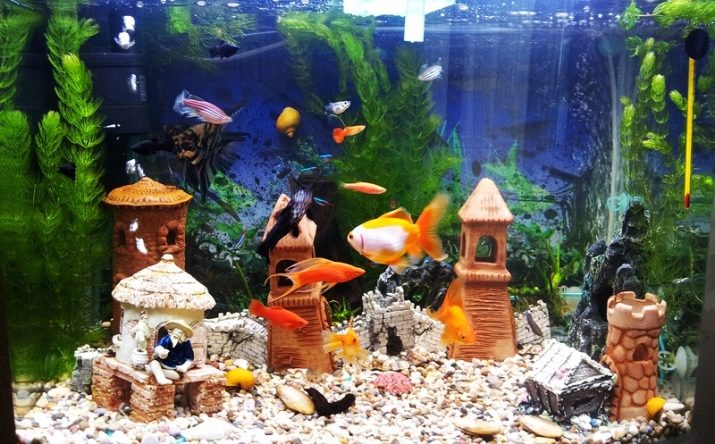
To make the roomy 200-liter container a sophisticated addition to your interior, it is important to follow the instructions for installing, buying and populating your aquarium, and then taking proper care of its inhabitants. Then a corner of the underwater world will also become a source of pride for the owner.
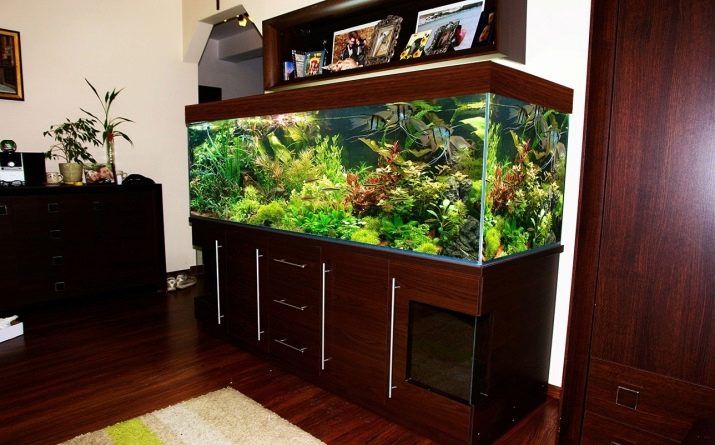
You can get acquainted with the features of the maintenance of a 200-liter aquarium in the following video.








